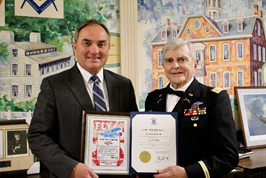Piedmont CEO inducted into RI Aviation Hall of Fame

On an icy winter afternoon in Rhode Island in 1982, pilot Lyle Hogg helped land Pilgrim Airlines Flight 458 as the cockpit of his deHavilland Twin Otter was burning. The flames from a faulty de-icing system melted the crew’s headsets and ate through their uniforms. First Officer Hogg and Capt. Thomas Prinster managed to navigate the aircraft from 4,000 feet and land successfully on the frozen Scituate Reservoir, saving the lives of nine passengers on board.
For his heroic efforts, Lyle, now President and CEO of Piedmont, was recognized by the Rhode Island Aviation Hall of Fame, along with eight other honorees, in Providence, Rhode Island, this past weekend. Former co-workers at Pilgrim Airlines surprised Lyle by attending the event. He was introduced via video by former American Airlines chairman (and Rhode Island native) Bob Crandall.
Lyle still reflects on how many people contributed to the success of that rescue. When air traffic controllers realized the aircraft wasn’t going to make it to the airport, they ensured the local police and volunteer fire department were on the lookout for the incoming plane. Emergency responders took the injured passengers to hospitals 17 miles away on back country roads, in less than 30 minutes. Doctors were scrubbed, nurses were ready and people had already been designated to take care of their families.. The quick actions and extraordinary efforts of all those involved in the rescue that day are what Lyle says saved his life.
After spending a year in hospitals recovering from severe burns, Lyle returned to Pilgrim Airlines and continued flying. He was hired by US Airways in 1984, where he later became vice president of Flight Operations, and eventually, Piedmont CEO.
The passengers who survived that day included a college football player who returned to the field the following semester, a 9-year-old girl and a Holocaust survivor who, at 89, continues to practice medicine and write about his experience in World War II.
Thomas Prinster spent two years recovering from burns over 75% of his body and only briefly returned to flying. The pilots lost touch for two decades, but were reunited in 2016 when they spoke on a radio program during the release of Sully: Miracle on the Hudson. Thomas died a year after the broadcast from complications of lung damage from the accident.
Lyle applies much of what he experienced that day to his leadership style, including an emphasis on compliance, training and preparation.
“I tell our new pilots, you don’t know which flight will define your career. Make each one your very best.”
Read more: Pilots honored for landing burning plane on the frozen reservoir